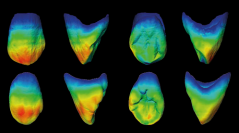

 Comptes Rendus Palevol
18 (1) - Pages 72-89
Comptes Rendus Palevol
18 (1) - Pages 72-89Enamel and dentin patterns have awakened a considerable interest in phylogenetic studies. However, almost nothing is known about the dental tissue proportions of European Pleistocene hominins, apart from Neanderthal populations. This study aims to assess the three-dimensional dental tissue proportions of permanent canines belonging to the extensive sample of hominin teeth at Sierra de Atapuerca (Spain) through the use of microtomographic techniques. Our results show that early and middle Pleistocene populations from Atapuerca exhibit large coronal and root dentine dimensions, as well as a thinly enamelled pattern, which has been traditionally considered an autapomorphic Neanderthal trait. Therefore, these results might support an early enamel thickness decrease which is already observed 800 kyr ago in Homo antecessor and maintained in later groups such as Sima de los Huesos and Neanderthal populations during the middle Pleistocene.
Atapuerca, Canines, Dentine, Enamel, Microcomputed tomography